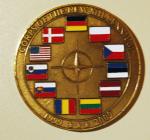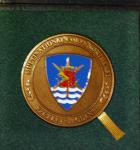-
Posts
5,629 -
Joined
-
Last visited
Content Type
Profiles
Forums
Blogs
Gallery
Events
Store
Everything posted by IrishGunner
-

Field Telepnone "L"
IrishGunner replied to Brian Wolfe's topic in Great Britain: Militaria: Badges, Uniforms & Equipment
A quick web search shows a reference on the REME museum page: Telephone Set L (YA 3717) Vol U03, EMER No U739, Dated 1955-Jul So, at least until 1955 - through the Korean War - and probably well into the 1960's. The US Army used its WWII version field telephone, the EE-8, well into the Vietnam War. It's replacement, the TA-312, was first used in the Korean War and has been used well into the current century. I suspect that the British version had a similar history. -
I would enjoy a bottle of Scotch and a few Cohibas on the battlefields... Unfortunately, not in the cards. :cool:
-
Still the most beautiful medal ever...IMHO. And an incredible story. Exceptional writing. This should be published.
-
I see he was in Cumberland, MD in 1942. While Cumberland is in the western mountains of Maryland, it isn't that far from Baltimore, which had a huge shipyard building ships in WWII. Circumstantial to say the least, but you never know...
-
I have seen BRCS medals with boxes before on eBay. I have an unnamed example on without a box. Since mine wasn't named, I didn't assume the boxes had names on them. Will have to watch closer now and maybe upgrade. The pride of my nurse collection is a Victory Medal named to Staff Nurse Daye; I have been able to do some research on her, but haven't found her specific wartime service.
-

Finland Mannerheim/German Medals WW1
IrishGunner replied to LTC Stahler's topic in Germany: All Eras: The Iron Cross
Mannerheim supposedly also received the French Legion de Honneur and the British OBE in 1938/39; around the same time he received the EK's. I am no expert either, but suspect the explanation above - he was a Marshall; so, he had to have the EK's as a matter of protocol. Same reason he probably received the French and British awards. Strange times. -

Finland Mannerheim/German Medals WW1
IrishGunner replied to LTC Stahler's topic in Germany: All Eras: The Iron Cross
Bob, actually Mannerheim served in the Imperial Russian Army - cavalry. During part of his service he was in partioned Poland as part of the Russian occupation. During WWI, he was on the Eastern Front fighting the Austrians and the Romanians and reached general officer rank. I am not an expert, but last month I had a special dinner with a Finnish colleague honoring Mannerheim's meeting with the Polish Marshall Pilsudski during both country's wars against the Bolsheviks after WWI. Mannerheim is sort of his hero (he has Mannerheim's picture hanging in his living room!). It was an interesting evening of history - also eating Mannerheim's favorite dishes (reindeer soup) and drinking many shots of his favorite drink... Now get this... Vodka; but not JUST vodka... Vodka mixed with vermouth and aquavit. Not a mixed drink, but rather it is distilled and bottled together. Strange tasting vodka basically. A month ago, I bought a postcard of what I thought was a German soldier; turns out he is actually Finnish (he's wearing the Winter War Medal ribbon). This picture was taken in a city in Finland, a port that my friend told me is where the Jaeger's returned from Germany after the war. I started to do a bit of looking into the 27. Jaeger, but haven't gotten too far. It was about the same time I started focusing on the German artillery. One of these days I need to invite my Finnish friend over for some vodka and pick his brain on the topic. -
This next one is for the 10th Anniversary (2009) of Multinational Corps Northeast, headquartered in Szczecin, Poland. This corps is available for NATO and actually the corps staff will shortly be serving as the bulk of ISAF Headquarters in Afghanistan. Again, about 3 inches in diameter; comes in a nice felt/cardboard box. (PS: This one could be available for trade. ) The front: The corps' emblem.
-
I finally brought these home from my office to post. Sorry for the poor image quality. My wife is the photographer and I have to be careful in the critique; she works for free! This first one is for the 90th Anniversary of the Polish General Staff, which was 2008. It comes in a very simple plastic case. The medal is about 3 inches in diameter. The front: "Sztab Generalny Wojska Polskiego" - General Staff of the Polish Army
-

Battle of Kemmel 23 April 1918 info sought
IrishGunner replied to IrishGunner's topic in The Great War 1914 to 1918
-

Battle of Kemmel 23 April 1918 info sought
IrishGunner replied to IrishGunner's topic in The Great War 1914 to 1918
Ok, I admit I am quickly becoming confused... I think 10. ED was part of IV Armee, but can someone confirm this... Stupid easy question: Was 10. ED part of IV Armee or VI Armee? :unsure: -
No question these are/were tough people in these mountains. I lived in Slovenia for three years and hiked/climbed a lot of the mountains on the Slovenia/Italy border in the Julian Alps where a lot of the fighting took place in WWI. Using Kobarid, Slovenia (Capparetto - also scene of Hemingway's book "A Farewell to Arms") as a base, you can trace a lot of the Isonza (Soča) Front; including the area where Rommel writes about in "Infantry Attacks". The Trentino and the Tyrol were even worse conditions - the fighting at San Matteo had to be insane. Every 11 Nov for a Veteran's Day ceremony we'd climb Mt. Krn (2245m); last time I started my day with a short run in shorts along the Soča (this is the Slovene name for the Isonza River), but mid-day however, I was slogging through almost two meters of snow to get to near the top of Mt. Krn and the ceremony. Of course, many of those making the climb were old partisans from WWII - no shortage of tough souls and strong drinks. I could only imagine how it was to fight in these mountains during WWI. Many of the fortifications and tunnels still exist as they were at that time. Driving the Vrsic Pass as described by Bob even today can be harrowing in the winter - assuming it's open. For the truly rugged, in June/July there is a marathon that runs up this road built by the Russians. To remind: Mt, Krn was the area of the initial assaults along the Soča River after Italy's entry into the war in May 1915. Italian Alpini achieved the first major victory on the Soča Front with the capture of Mount Krn, when they wrested this 2245-meter peak from the hands of from its Hungarian defenders on June 16, 1915. I have stood at the top drinking all sorts of fire water with Hungarians, Austrians, Germans, Slovenes, Italians, and a few crazy Americans! Footnote: Great trout fishing in Kobarid and Tolmin along the Soča River. In Kobarid is one of the best restaurants - serving seafood of all things - in which I have had the pleasure to dine anywhere in the world.
-

Battle of Kemmel 23 April 1918 info sought
IrishGunner replied to IrishGunner's topic in The Great War 1914 to 1918
I suspect you are right about the foot artillery being somewhat independent from the division at this point. From the published sources and from newspaper accounts of the time, artillery of all calibers were firing almost continuously during Lys. And with Bruchmueller involved, there likely was some centralized plan. Giving the volume of firing from anecdotal accounts, artillery almost certainly was not held in reserve and it is likely that all batteries were engaged regardless of what their division was doing. On the other hand, it is my opinion, that positioning of batteries likely followed some relative connection to division sectors. I don't have evidence of this, but it makes some sense, at least to me... So, following the 10. ED might be a blind hole, but it's a starting point. I really am only looking for a general story regarding artillery during Lys; since finding out what Gefreiter Euen himself and 3. Batterie, Fussartl Bn. 156 were doing is rather a long shot. In this case, the search is as instructive as the potential result. If I can get even half good at the foot artillery, imagine how easy the field guns will be... I will try to get the doc posted later tonight; unfortunately, I don't have an Epson (yea, yea, yea ) and don't intend to go that route until I move back to the US. For now, I am dependent upon my wife and her camera. :banger: -

Battle of Kemmel 23 April 1918 info sought
IrishGunner replied to IrishGunner's topic in The Great War 1914 to 1918
Chris, thanks for the reminder that the date on the document isn't necessarily the date of action. Based upon 251 Divs, I would agree that this was from 15-23 April - during the Battle of Lys. Quite a bit of artillery was being fired during this period, prepping the German offensive actions. And of course, lots of Allied counter-fire. A lot going on that could have earned an EK2. This is my first award doc research; so, I have no expectations. Would just like to come up with a general - yet plausible - story. -
I am researching an EK2 award document to a Gefreiter of Fussartillerie Battalion Nr. 156 awarded on 23 April 1918. This artillery battalion was part of 10th Ersatz Div, which has campaign credit for the Battle at Mount Kemmel. Other than overview articles of the battle, I have found nothing specific on the activities of 10th Ers. Div on 23 April (it would be a long shot to find something specific to FussArt. Batl 156). Any info concerning specifics of the 10th Ers. Div or the Fussartl Batl. 156 on 23 April 1918 would be sincerely appreciated. Newspaper accounts of the day (NY Times Archive) constantly talk about the heavy artillery activity from both sides. Any general info regarding the use of German artillery / tactics during the Battle of Kemmel would also be appreciated.







